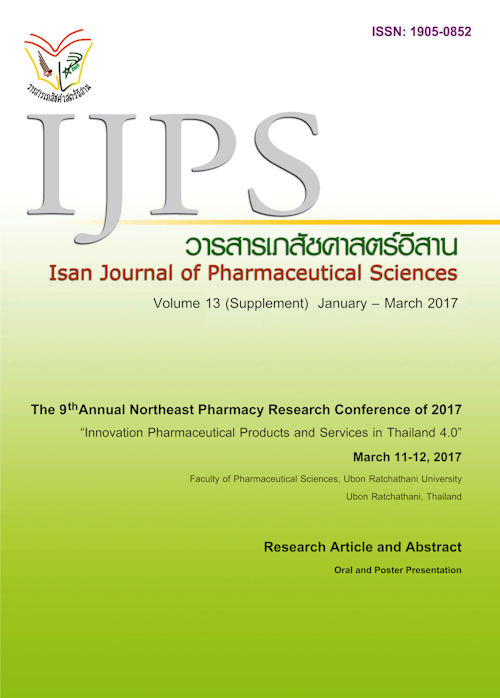การแยกอิแนนทิโอเมอร์ของฟีนิลไกลชีนโดยโครมาโทกราฟีแบบแลกเปลี่ยนลิแกนด์
Main Article Content
บทคัดย่อ
บทนำ: เนื่องจากฟีนิลไกลซีนในโครงแบบ “ดี” เป็นสารที่มีความสำคัญทางเภสัชกรรมโดยใช้ในการ สังเคราะห์แอมพิซิลลินและเซฟาเลกซิน ดังนั้น จึงจำเป็นต้องประเมินความบริสุทธิ์ทางอิแนนทีโอเมอร์ก่อน นำไปใช้ การศึกษานี้มีวัตถุประสงค์เพื่อพัฒนาวิธีการแยกไครัลสำหรับฟีนิลไกลซีนแทนการใช้คอลัมน์โครมาโทกราฟีของเหลวสมรรถนะสูงชนิดไครัลที่มีราคาแพง โดยการใช้วัฏภาคเคลื่อนที่ที่ประกอบด้วยคอปเปอร์และแอล-โพรลีน ร่วมกับวัฏภาคคงที่ ได้แก่ คอลัมน์ชนิด C18 วิธีดำเนินการวิจัย: ทำการศึกษาหาสภาวะที่เหมาะสมสำหรับ การแยก ดี- และแอล-ฟีนิลไกลซีน ได้แก่ ค่าพีเอชของวัฏภาคเคลื่อนที่ ความเข้มข้นของคอปเปอร์และแอล-โพรลีน และร้อยละของเมทานอลในวัฎภาคเคลื่อนที่ และประเมินประสิทธิภาพของการแยกจากค่าการแยก ระหว่าง พีกของไอโซเมอร์ดีและแอล ตลอดจนลักษณะของโครมาโทแกรม รวมทั้งลร้างกราฟมาตรฐานเพื่อหาช่วงและ ความเป็นเส้นตรง ผลการวิจัย: เมื่อใช้สารผสมซึ่งประกอบด้วยคอปเปอร์และแอล-โพรลีนความเข้มข้น 2.5 และ 5 มิลลิโมลาร์ ในเมทานอลร้อยละ 10 ที่มีค่าพีเอชเท่ากับ 6 เป็นวัฎภาคเคลื่อนที่ พบว่า ดี- และแอล-ฟีนิลไกลซีน แยกจากกันได้ดีโดยปรากฏพีกที่เวลาประมาณ 5 และ 11 นาที ตามลำดับ ภายใต้สภาวะที่เหมาะสมนี้ความ เข้มข้นกับพื้นที่ใต้พีกมีความสัมพันธ์เชิงเส้นกันดี โดยมีค่าสัมประสิทธิ์สหสัมพันธ์เท่ากับ 0.9997 และ 0.9998 สำหรับ ดี-ฟีนิลไกลซีนและแอล-ฟีนิลไกลซีน ตามลำดับ สรุปผลการวิจัย: วัฎภาคเคลื่อนที่ที่ประกอบด้วย คอปเปอร์ แอล-โพรลีน เมทานอล และมีค่าพีเอชที่เหมาะสม ร่วมกับคอลัมน์ชนิด C18 สามารถใช่ในการ แยกอิแนนทีโอเมอร้ของฟีนิลไกลซีน ดังนั้นจึงสามารถนำสภาวะนี้ไปพัฒนาและตรวจสอบความถูกต้องของวิธี วิเคราะห์หาปริมาณ ดี- และแอล-ฟีนิลไกลซีนที่ทำได้ง่ายและมีราคาถูกในลำดับต่อไป
Article Details
กรณีที่ใช้บางส่วนจากผลงานของผู้อื่น ผู้นิพนธ์ต้อง ยืนยันว่าได้รับการอนุญาต (permission) ให้ใช้ผลงานบางส่วนจากผู้นิพนธ์ต้นฉบับ (Original author) เรียบร้อยแล้ว และต้องแนบเอกสารหลักฐาน ว่าได้รับการอนุญาต (permission) ประกอบมาด้วย
References
Davankov VA, Kurganov AA. The role of achiral sorbent matrix in chiral recognition of amino acid enantiomers in ligand-exchange chromatography. Chromatographia. 1983, 17(12): 686-690.
Hu SQ, Lu WJ, Ma YH, Hu Q, Dong LJ, Chen XG. Chiral separation of β-blockers by MEEKC using neutral microemulsion: analysis of separation mechanism and further elucidation of resolution equation. Electrophoresis. 2013, 34(2): 260s268.
Husain S, Sekar R, Ran RN. Enantiomeric separation and determination of antiparkinsonian drugs by reversed-phase ligand-exchange high-performance liquid chromatography. J Chromatogr A. 1994, 687(2): 351-355.
Lam S, Malikin G. Strategy combining chiral chromatography with β-cyclodextrin and stereospecific enzyme reaction detection with hydroxysteroid dehydrogenases for resolving steroid epimers. Chirality. 1992, 4(16): 395-399.
Machelli R, Corradini R, Galaverna G, Dossena A, Dallavalle F and Sforza S. Chiral separatioin techniques. Wiley, New York, 2007, p 301.
Mericko D, Lehotay J, Cizmarik J and Slov C. HPLC separation of enantiomers using chiral stationary phase. Farm. 2007, 56(3): 107-113.
Pirkle WH, Pochapsky TC. Consideration of chiral recognition relevant to the liquid chromatography separation of enantiomers. Chem Rev. 1989, 89(2): 347-362.
Sajewicz M, Gontarska M and Kowalska T. HPLC-DAD evidence of the oscillatory chiral conversion of phenylglycine. J Chromatogr Sci. 2014, 52(4): 329-333.
Sotgia S, Zinellu A, Pisanu E, Pinna GA, Deiana L, Carru C. Enantiomeric reversed-phase high-performance liquid chromatography resolution of D-/L-penicillamine after spirocyclization with ninhydrin and by using copper(II)-L-proline complex as a chiral selector in the mobile phase. J Chromatogr A. 2008, 1205: 90-93.
Victery W, Tyroler HA, Volpe R and Grant LD. Summary of discussion sessions: symposium on lead-blood pressure relationships. Environ Health Perspect. 1988, 78: 139-155.
Wang LJ, Hu SQ, Guo QL, Yang GL, Chen XG. Di-n-amyl L-tartrate-boric acid complex chiral selector in situ synthesis and its application in chiral non-aqueous capillary electrophoresis. J Chromatogr A. 2011, 1218: 1300s1309.
Wang LJ, Yang J, Yang GL, Chen XG. In situ synthesis of twelve dialkyltartrate-boric acid complexes and two polyols-boric acid complexes and their applications as chiral ion-pair selectors in nonaqueous capillary electrophoresis. J Chromatogr A. 2012, 1248: 182s187.
Wu Y, Zhai Y, Zhang Y, Zhang H, Jing H, Chen A. Chiral separation and determination of amino acids in real samples by LE-MEKC using Cu(II)-L-proline as chiral selector. J Chromatogr B. 2014, 965: 254-259.
Yamazaki S, Saito Katsunori, Tanimura T. Enantiomeric separation of underivatized aliphatic β-amino alcohols by ligand-exchange chromatography using N-n-dodecyl-(1R,2S)-norephedrine as a coating reagent for reversed-phase column. J Sep Sci. 1994, 21(10): 561-564.
Zukowski J, Pawlowska M, Pietraszkiewicz M. Enantioseparation of α-phenylglycine by HPLC on an ODS column coated with chiral crown ether. Chromatographia. 1991, 32(1): 82-84.

